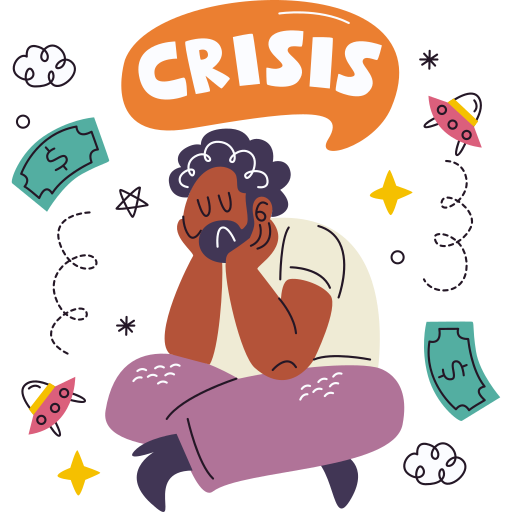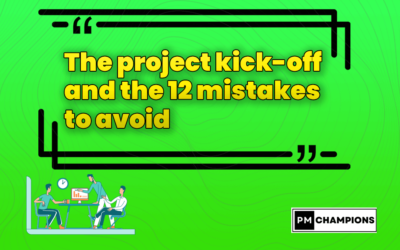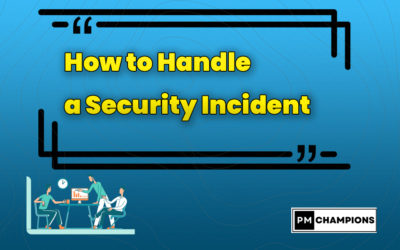Recommendations for managing a project crisis
Although every effort is made to understand potential problems on a project in terms of risks, it can happen that a crisis still occurs.
 But what is a crisis?
But what is a crisis?
This is a situation in which the project literally goes off the rails: it can no longer be managed within the usual framework.
The reasons can be diverse and varied, latent or unexpected, unitary or plural:
- Loss of trust
- Recurring problems
- Conflicts between people
- an exogenous event
- A change that has been undergone
The symptoms can also be heterogeneous:
- Disagreements
- Late or non-completed validations
- Tension in exchanges
- Carpet noises
- Degraded indicators
- Stiffened postures
- escalation
- Distancing of certain actors
The following recommendations will be of great help in managing a crisis:

Agility:
A. Staying Calm
 A crisis can trigger a range of behaviors among stakeholders that are not conducive to dialogue or the search for compromise/solutions:
A crisis can trigger a range of behaviors among stakeholders that are not conducive to dialogue or the search for compromise/solutions:
- denial
- anger
- irrationality
- frustration
- aggressiveness
- Bad faith
It is important not to give in to emotion and to remain in a soothing, courteous and constructive professional posture.
B. Be clear-eyed about the situation
Analysis of the situation is the first action to be taken.

It is a question of making the observation:
- What is the exact nature of the malfunction(s)?
- What is the extent of the damage?
- What are the observed and foreseeable consequences?
All the elements of the response will feed into the action plan to be undertaken and will make it possible to inform/involve the stakeholders.
C. Be transparent
Clear and concise language, structured and intelligible speech, verifiable data, honest handling of information.

This is the recipe for communicating while minimizing the risks associated with misinterpretation and/or incorrect perception, both internally and externally.
D. Investigating the Causes
Often, a crisis is a continuation or superposition of dysfunctions.
It is often easy to take shortcuts to justify the crisis and point to responsibility before even trying to resolve it.

The causal chain must be established objectively and factually BEFORE any conclusions can be drawn.
E. Refer to the framework
The contract and the structuring documents validated as part of the collaboration of the stakeholders (Project Plan, QAP, etc.) are authoritative, and even more so in a crisis situation.

Of course, the impact of the crisis must be understood from the point of view of commitment, and in particular penalties, but it is also necessary to ensure that the management of the crisis itself fits into the framework.
F. Changing the Rhythm
The challenge here is to increase visibility and show progress in the short term.
Closer and simpler milestones are recommended.
Shorter and more frequent
governance
bodies maintain a sense of urgency while strengthening control of the situation.
Communication follows this same logic; It is more sustained and operational in its tone.
G. Strengthening Proximity
For the involvement and empowerment of all actors as well as for the reassurance of everyone, interpersonal relations must be more dense.

Increasing the number of formal and informal exchanges contributes to closer and more controlled collaboration in the direction of exiting the crisis.
H. Concentrating the Actors
As useful information is more available through communication, the purpose of meetings is less to inform than to speed up decision-making.

This de facto implies a limited number of participants who are representative of the stakeholders, who are not spectators but protagonists of the action.
I. Writing, formalizing, tracking
It’s a commonplace in project management: you have to write it down.
In a crisis situation, this is exacerbated: reports, exchanges, etc.

Everything has to be formalized. This approach is useful for several reasons:
- 1. It supports and secures tracking
- 2. She protects the team in the event of a future “witch hunt”.
J.Addressing Root Causes
Once the urgency of the crisis has been managed, it is not uncommon for us to find ourselves with a volume of work to catch up with, due to the mobilization of the teams on the emergency and… that we forget to tackle the real fundamental problems, at the risk of seeing them repeated.

It is time to perfect your diagnosis and plan the basic actions, before undertaking them and sticking to them.
K. Lifting Measures
A crisis takes place in a given time, within a limited period of time.
As soon as the actions bear fruit and the symptoms disappear, the measures must be lifted.

However, it must be gradual and controlled, so as to avoid a possible relapse.
It must be coordinated with stakeholders and, in particular, the customer.
L. Record
The crisis needs to be documented.
If the operational situation returns to normal, further discussions will surely begin with the aim of identifying the responsibilities and the associated potential damages.

A report is essential to describe in detail what happened and how it was remedied.
This relationship is all the more necessary as the more time passes, the more history will be reinterpreted.
M. Learn
There are always lessons to be learned from a crisis situation, whatever it may be: on the primary reasons, the system implemented, the collaboration with stakeholders, the existing or missing processes, etc.

A post-mortem with the project team and a feedback with the client will make it possible to turn the page on this crisis episode from the top.
N. Restart
The crisis disrupted the normal course of the project.
Once the storm has passed, it is necessary to resume the normal course of the project, which cannot be done without a prior reframing phase: it is a question of considering the impacts of the crisis in terms of costs,planning,budget,risks, etc.

So that the objectives of the project can be secured with full knowledge of the facts.






0 Comments